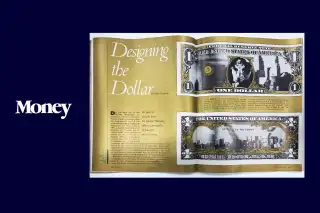Money Classic: America's Top Artists Redesign the Dollar (1986)

Money is turning 50! To celebrate, we’ve combed through decades of our print magazines to uncover hidden gems, fascinating stories and vintage personal finance tips that have (surprisingly) withstood the test of time. Throughout 2022, we’ll be sharing our favorite finds in Money Classic, a special limited-edition newsletter that goes out twice a month.
This excerpt, featured in the 13th issue of Money Classic, comes from a story in our November 1986 edition.
Did you know that in 1896 Martha Washington appeared on a $1 silver certificate, the only female to adorn an American bank note? Or that U.S. bills were once as large and colorful as Italian lire? Or that, as late as 1901, a buffalo roamed on a $10 Treasury note? Indeed, the Almighty Dollar, which assumed its present size only in 1929, has undergone multiple permutations over the years. Now it is about to be changed again. A subtle and (currently) unreproducible metallic filament will soon be added by the Bureau of Engraving and Printing to foil increasingly sophisticated high-tech counterfeiters. So unless you are cranking out bogus bills in your basement, this tiny modification will mean nothing to you. Yet it did lead Money's editors to wonder: Why not redo the dull dollar to convey more vividly a sense of what the U.S. thinks of itself today?
With this admittedly playful idea in mind, we invited seven of America's leading visual tastemakers to redesign the dollar.
"It's important to establish the modern woman on currency," says fashion designer Donna Karan, 38, "and New York represents the environment in which that woman lives." Karan, whose name has become synonymous with Manhattan chic, designed her dollar with her own image in the place of honor and the New York skyline dominating the front and back of the bill. As chief designer of the Anne Klein Collection, Karan won Coty Awards (the fashion industry's Oscar) in 1977 and 1981. After election to the Coty Hall of Fame in 1984, she founded her own firm, Donna Karan New York.
An internationally celebrated designer, painter and illustrator, Ivan Chermayeff, 54, shows us that the buying power of the dollar has diminished, but we can maintain the illusion of magnitude — with his stretched dollar above. He says: "It is designed to make one feel that one has something really worth one dollar — to peel off, light cigars with, and leave for tips." By contrast, his pocket-size dollar is "shrunk to fit your wallet or purse and to more accurately reflect its value."
Angela Cummings, one of the foremost U.S. jewelry designers, has crafted a dollar that is an exquisite (not to say expensive) counterfeiting deterrent. "Mine consists of 100 diamonds, 13 sapphires and three ounces of 24-karat gold," she explains. "I wanted to produce a dollar no one would or could copy." Cummings designed jewelry, notably in unusual shapes, for Tiffany & Co. in New York City for 18 years before founding Angela Cummings Inc.
Interior designer Mario Buatta, known widely as "The Prince of Chintz" for his lavish use of lush fabrics, thinks that money "should be made out of chintz, because it should be washable — though not laundered. I think of money as being dirty. Anyway, it will last longer if it's made from fabric." Buatta adds, "The two roses are there because the rose is the national flower. The dog is Rex, President Reagan's dog, who's there to protect the country."
Roz Chast, only 31 yet a favorite cartoonist amongst readers of The New Yorker for the past eight years, favors an annual competition among big moneymakers to produce a new face on the dollar each year. Her nominee and his family, as pure Chastian figments.
Alan Flusser, 41, one of the country's hottest men's wear designers, fashions smart clothes — and here, an equally sharp dollar — for the man who is out for a traditional yet stylish good time. "For me," says Flusser, "money has always represented an opportunity to have fun. To emphasize that, I have chosen to depict two familiar American icons, George Washington and the Statue of Liberty, out on the town. The addition of a female image serves notice that George is no longer footing the bill alone." Flusser notes that he has had his own clothes — though not his dollars — custom-made since he was 17 years old.
The most antic contribution — as well as the one least likely to ever grace a Treasury note — comes from so-called graffiti artist Keith Haring, 28, who in the past five years has made a brilliant mark both on the street and in the salon. In his singular view, the father of our country should be replaced by a Pop Art rodent. "Andy Mouse is a combination of Mickey Mouse and Andy Warhol," he explains. "You want to put the President on the dollar, and Andy Mouse is the President of Art." Starting with chalk sketches of barking wolves and glowing babies on New York subway billboards, Haring's street surrealism now sells for as much as $2,000 a drawing.
Subscribe to Money Classic.